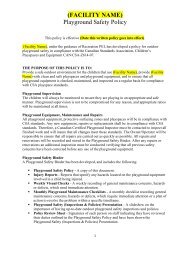Program Manual - Recreation PEI
Program Manual - Recreation PEI
Program Manual - Recreation PEI
- No tags were found...
You also want an ePaper? Increase the reach of your titles
YUMPU automatically turns print PDFs into web optimized ePapers that Google loves.
Heritage RoadsTunnels of sugar, maple, red maple, beech, and red oak, bordered by lupins, black-eyedSusan’s, daisies, and Queen Anne’s lace…..Prince Edward Island’s heritage roads are delightfulpathways to the Island’s rural past. These red clay, sun-dappled roads bordered by wildflowers andnative shrubs twist along fields and through wooded hills. In their day, they were commonly traveledroads between communities, connecting farms to saw-mills and furniture factories. Having escapedasphalt paving, these clay lanes and their surrounding vegetation are now protected from alteration.Island wildlife also enjoy these roads which serve as corridors for foxes, squirrels, and snowshoe haresand as nesting areas for song birds. The Island’s heritage roads constitute a cultural and naturalheritage unto themselves.In Prince Edward Island, scenic heritage designation of roads became possible in 1987.Under the Planning Act regulations, individuals are prohibited from cutting or removing trees,shrubbery or plant life or in any way altering the landscape of a scenic heritage road without writtenpermission from the minister responsible for the environment. There are sixteen heritage roads acrossthe Island: three in Prince County, nine in Queens, and four in Kings County. All informationregarding the Island’s Heritage Roads is courtesy of the Government of <strong>PEI</strong> Webpagehttp://www.gov.pe.ca/infopei/index.php3?number=3553&lang=E.Prince County Heritage RoadsJohn Joe Road: A pleasant rural lane where fields of grain and potatoes alternate with woodland toform the border, this patchwork of farm and forest creates ideal conditions for the ruffed grouse andgrey partridge. Corn-lily, bracken fern and trillium are found under the tree cover. This road has twolocal names, the John Joe Road and the Hackney Road. The former is after a man by the name of JohnJoe Gallant, a past resident of the road, the latter from a Mr. Hackney who is believed to have beeninvolved in its construction around 1912-14. Prior to this time the road was a cart track that led to ahomestead in the wood. Traces of an old stagecoach road that stretched from the Kelly Road towardAlberton are found near the southern end. Location: Officially unnamed but locally known as theJohn Joe Road, this trail runs north from the Kelly Road (Rte 142) for 2.2 km to meet Rte. 136 nearMill River Resort.Walls Road: Open farmlands encompass either end of this variable lane until it breaks into a lovelywoodland scene where the road crosses the Dunk River. Spruce, birch, pin cherry and alderssurrounding this area and common wildflowers enhance the picture. Upon closer exploration you maydiscover the provincial flower, the pink Lady's Slipper. Common to the area are muskrats, greypartridge and red fox. The rare but showy bald eagle has also been spotted along here. Officially thisroad is unnamed, but it is well known in the area as Wall's Road. About 1868 the road and Wall'sMills, which included a saw and grist mill, were constructed. A shingle mill was added by 1880. By1900 the mills had ceased operation; the only reminder of their existence is the flattened area near theriver which now provides a great spot for picnics. Nature lovers and fishing enthusiasts willappreciate this road/river combination, as will those seeking winter recreation such as skiing orsnowshoeing. Location: West of Scales Pond Park in the Freetown area, Wall's Road runs south fromRte. 113 to Rte. 111 for 1.5 km.













